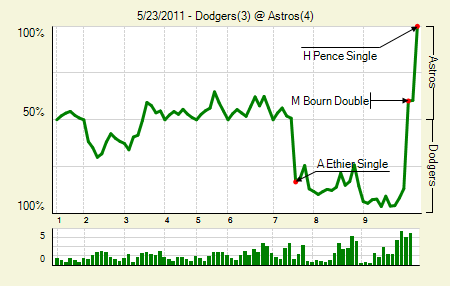After reaching the playoffs for the first time in fourteen seasons in 2010, the Cincinnati Reds entered this season with huge expectations. The main reason for optimism centered around the return of Edinson Volquez. Though Volquez technically pitched for the Reds last season, he was still recovering from the effects of Tommy John surgery. Finally expected to be healthy for the entire season, it looked as if the Reds finally had their ace. That hasn’t been the case, however, as Volquez has struggled mightily in his return. After only ten starts, the Reds have sent Volquez back to Triple A to see if he can work out his issues. On top of demoting their Opening Day starter, the Reds are also in the midst of a six-game losing streak. With all their recent issues, is it time to start worrying about the Reds? In a word, no.
The Reds were able to win the NL Central last season with a minimal contribution from Volquez. Due to his recovery from Tommy John, Volquez returned in late-July, and pitched only 62.2 innings for the Reds. Even if Volquez remains in the minors for the rest of 2011 – an unlikely scenario – the Reds can still contend for the division without him considering they already did it last season.
The loss of Volquez shouldn’t hurt the Reds all that much due to their strong pitching depth. As Albert Lyu chronicled before the season, the Reds had multiple starters competing for only five rotation spots. Even though Volquez and Mike Leake haven’t panned out, the Reds still have a decent four-man staff. While they haven’t announced who will take Volquez’s spot in the rotation just yet, Sam LeCure and Matt Maloney could be decent placeholders for the time being.
Their period in the rotation may be short-lived, however, as Volquez or Leake could return at any moment. The Reds voluntarily chose to remove both pitchers from the rotation due to their poor performances, not due to injury. Although they may have been demoted, they are not gone for the season. The Reds can still call upon Volquez or Leake whenever they deem it necessary.
If the Reds hope to reach the same heights as they did last season, their offense is going to have to remain strong. After finishing 1st in offensive WAR last season, the Reds have nearly kept up the pace in 2011. Instead of experiencing regression after his MVP season, Joey Votto may actually be getting better. With Brandon Phillips again turning in another fine season and Jay Bruce finally manifesting the power everyone expected, the Reds once again have a promising core of hitters. That’s true even without mentioning Drew Stubbs, who is currently experiencing a nice breakout season.
All told, there’s little reason to worry in Cincinnati. Despite the losing streak, the Reds are only 3.5 games out of first place. Since we know not to overreact to small samples, we should expect the Reds to turn things around soon. The temporary loss of Volquez shouldn’t alter our expectations, as the Reds were able to win the division with a minimal contribution from him last season. This current version of the Reds is much like the team we saw last season. Their pitching is good enough to keep them in games, but their offense (and defense) is what will ultimately propel them to a division crown. The Reds may appear more vulnerable than they did last week, but in reality little has changed.



